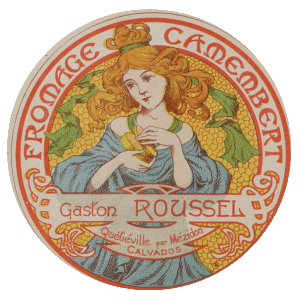
To serve it...
The camembert cheese can be eaten during the whole year but it is better during spring when the quality of the milk is higher.
Its crust should look like a thin white down, and may be covered with very little red dots. Under the crust the cheese should be supple and should have a beautiful light yellow color. To be sure of the quality of your cheese, you can press lightly the camembert cheese with your thumb, and with practice you might get a good "norman thumb".
The camembert cheese can be kept in a fridge between 5 and 10 Celsius degrees, but it is better to eat it when its temperature is comprised between 18 and 20 Celsius degrees. Therefore, it should not be kept in the fridge till the last minute.
To complete your cheeseboard , you can also add other excellent norman
cheeses such as the Livarot, the Neufchatel or
the Pont-L'Evèque.
The camembert cheese (that belongs to the familly of the flowered ripened
cheeses) has a strong taste. Therefore it may denature a great wine, so
you may prefer to serve it with a young red wine a little tannic.
The camembert can be served on a very simple cheeseboard, it must be served cut into and it must not be too ripe. To ensure that, be sure that there's no odour smelling like ammoniac.
Cooking camembert
Generally you eat the camembert with bread and without cooking it. Nevertheless many cooks have created recipes based on camembert, generally they unrippen it before using it.
You may also found camembert cheeses matured with cider or "Camembert hearts with Calvados". The first ones are based on young camembert steeped into cider, and the second one of camembert unrippened and steeped into calvados.
Alain Favris, a chocolate-maker in Argentan (Normandy) went further and created camembert chocolates. These chocolates called "diamants normands" (Normand diamonds) have fans and opponents among the camembert eaters! An ice-cream manufacturer in Colombes had a very similar idea and created a camembert ice-cream, served on hot toasts.
Camembert composition
The camembert can hardly be considered as a "light" product even if you taste it with moderation (and that would be a pity). Nevertheless many sacrifice their wreistline for the pleasure of tasting that beautiful flavour. On the other hand, one should remember that the camembert also contains many of the elements that are needed for the child growth.

Composition of the camembert cheese (250g)
A consummer mus /t be aware of the danger that may sometimes be linked
to a product. I'll try to present you some of the camembert ones (all
things considered, making all due allowance...).
The first danger is linked to the percentage of fat contained in that
cheese. Therefore, as many other cheeses it must be banned from many diets.
Moreover the most dangerous thing that can happen (and fortunately it's
rather rare) is the presence of numerous listeria monocytogenes bacteria
in the camembert cheeses (made with crude milk).
This bacteria that is present in small quantities in many products (Sea
shells, pastries, meats) can become dangerous if the number of bacteria
per gramm rises up to 100. Unfortunately the cheeses made with crude milk
may become good environment for the development of those bacteria if the
hygien is not perfectly respected during the making of the cheese.
Generally that infection is not lethal, but it can become really dangerous for the people with weak immune systems such as the older people, the children and moreover the pregnant women and their children.
To prevent these infections in France the"Direction générale de la concurrence,
de la consommation et de la répression des fraudes" with the "Direction
générale de l'alimentation" created a comission that looks after that
kind of problems and organizes tests all over the diaires.
The danger can be indeed completely suppressed if the hygien is stricly respected.

Benefits of raw milk cheeses
In information campaigns that historically aimed at ensuring the health of the public but which over time have sometimes been taken over by companies or distributors who found it easier to deal with pasteurized milk, more stable, more docile , and more predictably, we castigated cheeses raw milk (sometimes wrongly as seen in the previous chapter) and especially we forgot to mention the benefits.
It is therefore necessary to restore some truths.
The first "advantage" of raw milk camembert is its taste, because its rich microbial flora contributes to its taste, and it is impossible to reproduce this richness by post-pasteurization seeding.
This same microbial flora can also have beneficial effects on the quality of the cheese. Indeed, some of the modifications that it causes (acidification by organic acids, presence of ethanol ...) prove to be unfavorable factors for many pathogenic bacteria.
Finally, recent studies tend to show that raw milk consumed in youth (directly or in the form of cheese) reduces the risk of allergies (atopisms) and reduces sensitivity to allergenic factors.
Taking into account all this information, we realize that once we have set up a flawless quality monitoring during the production and its distribution the raw milk camembert is far from being contrary), this big bad wolf that we are sometimes depicted ...
